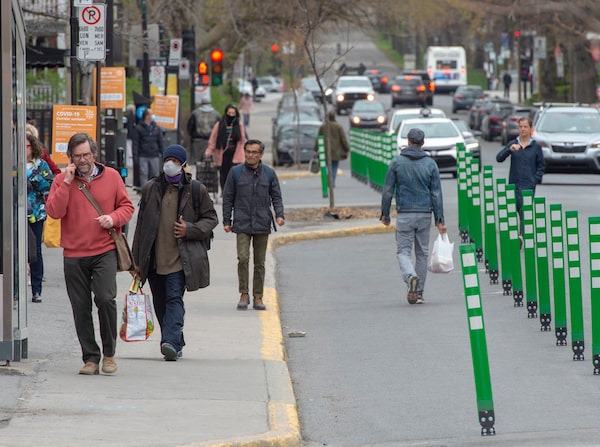
Pedestrians walk along a street in Montreal on May 15, 2020. The city has announced it will close over 300km of streets to only bicycle and pedestrian traffic to encourage physical distancing.Ryan Remiorz/The Canadian Press
Lisa Helps is the mayor of the city of Victoria.
COVID-19 has laid bare the vulnerabilities of Canadian cities for all to see. The number of people experiencing homelessness – so visible when everyone else is told to stay at home – means we need to take a more aggressive and inclusive approach to building affordable housing. And the very best way to prevent the spread of the virus is through physical distancing when out in public. Yet the majority of public space in cities has been dedicated to cars. This means we need to rethink and reorganize our public spaces.
Then there’s climate change. Environmental economists estimate that global emissions might fall by 8 per cent in 2020 owing to COVID-19. This reduction has come with economic turmoil, job losses and the potential onset of a global recession. Yet the United Nations Environment Program estimates that we need to keep reducing global emissions by 7.6 per cent every year from 2020 to 2030 to keep temperature increases from reaching catastrophic levels.
How do we continue to cut emissions to save ourselves and the planet at the same time as creating good jobs and prosperity for everyone? How do we build back better and ensure that any recovery plan for our cities, provinces, country and world creates more resilient, prosperous and inclusive communities? The 2020 Declaration for Resilience in Canadian Cities – a manifesto and a call to action that has been signed by current and former mayors and premiers, city planners, civil society leaders, architects and real estate developers, business leaders and artists from across the country, as a pledge to renew our cities, postpandemic – outlines a clear, bold path. I’ve added my name to this declaration, because the time for courage is now.
Indeed, despite the Declaration’s faith that cities will be able to enact its ambitious and practical goals – ensuring the responsible use of land, accelerating the decarbonization of our transportation systems, and embracing sustainability in our built and natural environments – it won’t be easy, in practice. “While some of the commitments … will require a response from, and co-ordination with, provincial and federal governments for funding," it argues, "the majority of these recommendations require simply a reallocation of resources and a reassessment of priorities away from unsustainable, inequitable, costly approaches that are not viable over the long-term toward sustainable, cost-efficient, future-oriented approaches.” These reallocations will not be simple, especially since many of the recommended actions are already in the planning or implementation stages in Canadian mid-sized cities such as ours – and are generating enormous controversy.
The Declaration calls for the updating of zoning policies, to "allow more households to access existing neighbourhoods by permitting and encouraging appropriately scaled multi-tenanted housing, co-housing, laneway housing, and other forms of ‘gentle density’ to be built, as-of-right, alongside houses in low-rise residential neighbourhoods.” Last year, a group of Victoria residents took the city and a developer to court for the approval of a 22-unit town house project within a five-minute walk of a village centre. We won.
The Declaration also suggests prioritizing "the transformation of existing streets and roadways for active transportation both for the immediate, post-pandemic recovery period and as permanent measures by adding additional space that meets the needs of pedestrians, individuals with mobility challenges such as the elderly and people with disabilities, and cyclists. This can be accomplished by incorporating protected bike lanes and the principles of universal design into a contiguous ‘everywhere-to-everywhere’ network that makes cycling a safe mobility choice for people of all ages and abilities and every resident, in every neighbourhood.”
Returning city streets from cars to people is a fraught activity for mayors and councillors across the country. In the last municipal election, Victoria’s 32 kilometre All Ages and Abilities Bike Network was the ballot question. We won. But even still, my bike was vandalized multiple times. Council received thousands of e-mails. And our residents, for and against, kept the local paper full of letters to the editor.
Transformational change is not simple. For some people it feels like loss – loss of single-family-only neighbourhoods or the loss of the car as the privileged mode of transportation. Yet, as leaders of Canadian cities in a post-COVID world with potential climate catastrophe on the horizon, we must have the courage to confront this sense of loss and take bold action nonetheless. We must do this to create cities that are good for people to live well, now and for the future. If not now – after everything that we’ve all been through – then when?
Keep your Opinions sharp and informed. Get the Opinion newsletter. Sign up today.